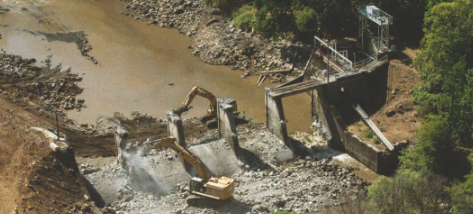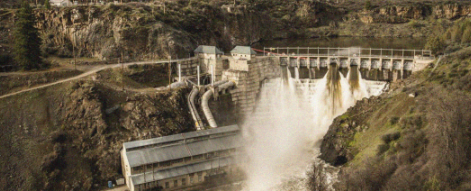
By the end of 2024, the Copco 1, Copco 2, J.C. Boyle and Iron Gate dams will be removed from the Klamath River. It will be the largest dam removal project in history.
The Klamath Tribes — composed of the Klamath, Modoc and Yahooskin-Paiute people — have inhabited the Klamath Basin for millennia. With a deep connection to the land and water, the tribes have historically relied on the Klamath River for sustenance, cultural and spiritual practices.
Stretching over 250 miles, the river — traveling from the Upper Klamath Lake in south-central Oregon, through California and into the Pacific Ocean — has supported both people and the environment for centuries. Native fish such as Pacific lamprey, green sturgeon, eulachon smelt, coastal cutthroat trout, steelhead trout, Chinook and coho salmon have historically thrived in the water — with the latter three migrating exclusively to the root of the river to spawn.
The Klamath Tribes were once some of the most prosperous and economically stable tribes due to their access to consistent abundant resources. Trading, ranching and fishing systems were established long before the land was discovered by white settlers.
Outsiders originally came for gold — a mineral said to be plentiful in the Kalamath’s vast waters — but stayed for the river. Colonizers were quick to realize the land’s potential, and the occasional American fur trapper turned into thousands of pioneers eager to become profitable farmers.
By 1864, the Klamath Tribes had lost more than 23 million acres of land. They were moved to a reservation, maintaining rights for hunting, gathering and fishing “in perpetuity.”
As the rest of the United States continued to expand westward, a wave of dam construction, driven by the promise of hydroelectric power, swept across the country. The trend diminished many tribes’ water access, as non-Indigenous settlers began diverting streams, rivers and lakes for their own prosperity.
The siphoning of these resources eventually resulted in the 1908 Supreme Court case Winters v. United States, when the Fort Belknap tribes claimed that their water rights, dating back to the creation of their reservation in 1888, had been infringed upon by upstream users. The case’s central issue was whether the establishment of the reservation implied a right to the water necessary to fulfill the purposes of the reservation.
In a majority opinion written by Justice Joseph McKenna, the Supreme Court articulated a groundbreaking principle of water rights. Known as the Winters Doctrine, the Court’s decision stated that when the federal government created a reservation for Native American tribes, it also implicitly reserved sufficient water to fulfill the reservation’s purposes.
The Court’s decision ensured that Native American tribes held senior water rights compared to later non-Indigenous settlers. This recognition was based on the understanding that water was essential for the tribes’ economic self-sufficiency, as well as for sustaining their traditional ways of life.
While the fight for water rights was just beginning in 1908, the push for dam construction was already well underway.
Two years before the Winters decision, the Reclamation Service (now known as the Bureau of Reclamation) began construction on the Klamath Project. The project aimed to create more irrigable land by draining lakes and wetlands, and provide irrigation for the surrounding farmland. The idea was that the power generated by the dams would boost the economy and create an agricultural boom for Oregon and California.
The Klamath Project took the form of six dams: Copco 1, Copco 2, J.C. Boyle, Iron Gate, Keno and Fall Creek. All were to be erected on the Klamath River and owned by utility investment company PacifiCorp. To further store Klamath Upper Basin water, artificial waterways like canals and ditches were to be constructed to drain and move the river.
Copco 1 (operational in 1918) and Copco 2 (operational in 1925) were built in Hornbrook, California, and named after the California Oregon Power Company (COPCO) — a business that later became Pacific Power, a division of PacifiCorp, in 1961. Copco 1 and 2 were designed for hydroelectric power generation and water storage. Both dams impound water to create reservoirs, and the flow of water through turbines generates electricity. J.C. Boyle, the closest of the six dams to Klamath Falls, was built in 1958 for further power production. Iron Gate, first operational in 1962, located near the Oregon–California border, was the largest dam, standing at 162 feet tall.
Fall Creek (constructed from 1902–1903) a small hydroelectric diversion dam, and Keno (constructed in 1931), a non-hydroelectric dam (meaning it wasn’t built to generate energy), are mainly used for regulating the flow of water and controlling reservoir levels. Both Fall Creek and Keno provide upstream fish passages via fish ladders and are popular today for recreational activities such as boating and fishing.
But while construction of the dams was being finalized, the Klamath Tribes started to take legal hits.
In 1954, Congress passed the Klamath Termination Act, effectively ending federal recognition of the Klamath people. The act discontinued federal social services, such as education, and reorganized tribal lands into areas that could later be sold.
Initially interested in their valuable timber resources, Congress justified the Termination Act with the reasoning that the Klamath tribes had successfully blended into conventional “white” society. Two decades after the act’s implementation, the majority of tribal members were living below the national poverty threshold.
In 1986, Congress passed the Klamath Indian Tribe Restoration Act, reestablishing federal recognition of the tribe. As part of the act, the tribes were directed to create an Economic Self-Sufficiency Plan (ESSP). The ESSP would help the tribes become more independent, and demonstrate their “continued commitment to playing a pivotal role in the local economy.” After years of deliberations, the Klamath people opened the Kla-Mo-Ya Casino in 1997, helping to boost the tribes’ financial recovery.
Still, the impacts remained. Over the span of 32 years, thousands of native people had their homes physically and legally removed; at the same time six dams built without regard for the Indigenous community continued to slowly chip away at a once-thriving ecosystem.
Since the introduction of the dams, the population of wild spring-run Chinook salmon — a fish native to the Klamath River — has declined by 98%. According to a 2002 analysis, at one time a half-million Chinook salmon came back to the river during the fall run. Today, that number has plunged to between 20,000 and 40,000. Additionally, multiple species native to the river including the Coho salmon, shortnose sucker, Lost River sucker, bull trout and eulachon smelt have all become threatened or endangered.
Once the third-largest salmon-producing river on the West Coast, the Klamath Basin watershed — covering more than 14,500 square miles — was cut in half due to the dams, preventing salmon from reaching spawning grounds upstream.
In 2002, over 34,000 fall-run Chinook and coho salmon were found dead on the surface of the Klamath River. The adult salmon swimming upstream to spawn began to disappear starting in mid-September. “Never in our time have we, the elders of the Yurok Culture Committee, seen such a mass destruction of our salmon resource,” said tribal elders at the time.
Due to a drought, there was a reduced volume of water in the river, leading to diminished river flow and higher temperatures. These characteristics created the perfect storm for an outbreak of the bacterial pathogen Flavobacter columnare and the parasite Ichthyophthirius. A 2004 analysis of the fish kill from the Yurok Tribal Fisheries Program explained that “The parasite feeds on the skin and gills of the infected fish. Cysts break off the fish, find substrate (the bottom of the river), and multiply into thousands of free swimming bodies called tomites. The free swimming tomites then seek out a new host, grow to full size, and the cycle repeats itself.”

However, there was a simple solution to avoiding the tragedy: speeding up the Iron Gate dam. A dam’s cubic feet per second (CFS) is the flow rate or discharge equal to one cubic foot of water per second. The higher the CFS, the faster the water moves, thereby cooling down the river and assisting organisms upstream. If Iron Gate had a CFS of 1000 or higher in the months leading up to the 2002 salmon migration, it’s likely that no fish would have perished.
“They had dropped the river levels to a level that I’d never seen in the over 15 years I’d been fishing there. So when I got there, we were very surprised to see … thousands of fish stranded in what you would call little tide pools,” said Stuart Warren, a fly fishing guide, in a 2018 OPB article. “Most of them were not living anymore.”
Meanwhile, PacifiCorp’s original licenses for the construction and operation of the Klamath River dams were approaching their expiration date.
PacifiCorp officially submitted their application for relicensing in 2004 to the Federal Energy Regulatory Commission (FERC), an agency overseeing the licensing of hydropower projects, including those on the Klamath River. As part of the relicensing process, comprehensive environmental assessments were conducted to evaluate the impact of dam operations on the river ecosystem. Three years later, FERC issued an environmental impact statement (EIS), evaluating the ecological impacts the dams had had since their building. FERC’s decision was clear: keep the dams, issue new licenses and provide sustainable fish passageways.
While FERC and PacifiCore were debating how to handle the dams, the Klamath Tribes decided to take action themselves. In 2010, the Klamath Basin Restoration Agreement (KBRA)
was published. This multi-stakeholder agreement, which included the federal government, Oregon and California state governments, Native American tribes, farmers and conservationists, strived to address water allocation, habitat restoration, fish species protection and harvest, as well as to “contribute to the public welfare and the sustainability of all Klamath Basin communities.” The agreement included provisions to remove the four dams located in the lower Klamath Basin (Copco 1, Copco 2, J.C. Boyle and Iron Gate). However, the plan was dependent on federal funding and legislation that was never approved, so it never officially materialized.
The KBRA did not go unnoticed by PacifiCorp — now interested in licensing its dams for removal, not renovation. After evaluating the EIS, PacifiCorp realized that
implementing the updated ecological standards necessary to continue operating the dams wouldn’t make economic sense and that it would be more cost effective to proceed with removal instead.Six years later the plan was revised into the Klamath Hydroelectric Settlement Agreement (KHSA). The KHSA set in motion months of transferring development licenses and revisions of the agreements, which culminated in September 2016, when PacifiCorp submitted the application to FERC to surrender its license for the Lower Klamath Project.
It wasn’t until November 2022 that FERC gave its final approval to remove the four dams.
FERC’s approval allowed the license for the hydroelectric project to be transferred to the states of California and Oregon and the nonprofit Klamath River Renewal Corporation (KRRC) to carry out removal of the dams.
Clayton Dumont, the Klamath Tribes chairman, told Ashland.news, “The Klamath Tribes are overjoyed by the news of the Federal Energy Regulatory Commission’s unanimous vote today to remove four dams from the Klamath River. Today’s decision underscores the need to move expeditiously to restore the health of our homeland ecosystem.”
Considering that the Keno and Fall Creek dams had a significantly lower environmental impact compared to the other four, they were voted not to be removed.
Following formal acceptance of the license transfer by the states and the KRRC, parties led by the KRRC have, and will continue to, take a number of steps during 2023 to lay the groundwork for complete removal of the dams. Resource Environmental Solutions is working with the KRRC to monitor the environmental impacts, and is responsible for restoring the reservoir footprints and other impacted areas associated with the construction portion of the dam removal.
The smallest of the dams, Copco 2, has already been removed in June of 2023. In January 2024, workers will begin draining the reservoirs behind the Iron Gate, J.C. Boyle and Copco 1 dams, then dismantle them with heavy machinery and some small explosives. Crews are also going to be planting seeds, many of which were collected by tribal members, along the riverbanks, as a step towards environmental restoration.
The removal of the dams promises the mending of the river’s natural flow and the reestablishment of crucial ecological processes such as sediment transport and nutrient cycling. By dismantling barriers to migration, salmon and trout can once again access critical spawning grounds, potentially initiating a resurgence in their numbers. This will help revitalize traditional fishing practices for the Klamath tribes, helping not only to preserve their cultural identity, but to foster economic opportunity for communities dependent on the river as well.
Dam demolition does not come without its drawbacks. Risks such as the release of accumulated sediment downstream have prompted concerns about affected water quality, and may introduce short-term disruptions to local ecosystems. Abrupt changes in water flow and sediment levels can impact riverbanks and surrounding habitats, making mitigation strategies essential for minimizing the adverse effects on aquatic life. The project’s cost — $450 million with a $45 million contingency fund — is going to be split between California taxpayers (covering $250 million) and PacifiCorps customer’s (primarily Oregon residents paying $200 million though surcharges.)
Pros and cons aside, it’s clear that the dams represented a seismic shift. The disruption of fish migration routes undermined traditional fishing practices, threatening the tribes’ culture and jeopardizing their economic independence. The river, once a source of abundance and spiritual significance, became a battleground for survival.
In the years to come, the Klamath River’s restoration will serve as a living testament to the positive outcomes achievable through environmental activism. The removal of these dams stands not only as a remarkable achievement for the Klamath community, but also as an inspiration for others to embark on their own journeys towards a more harmonious relationship with the natural world.
As the rivers flow freely once again, so too does the promise of a brighter, more sustainable future for all who call the Klamath region home.





